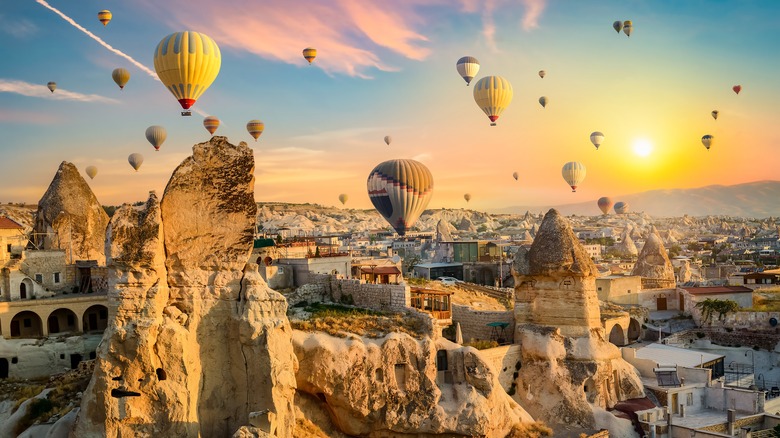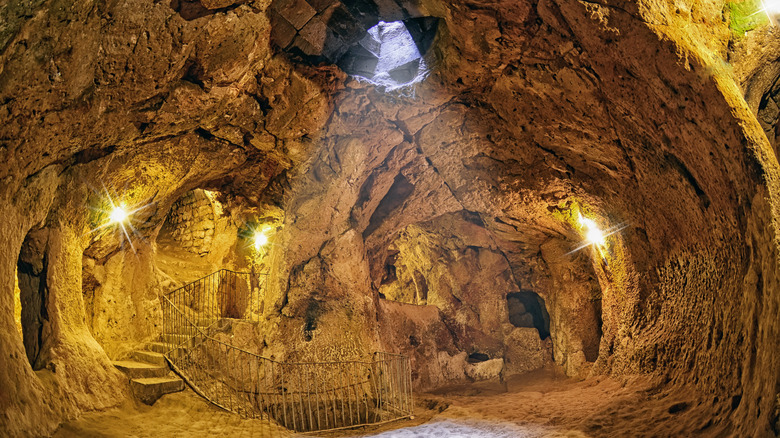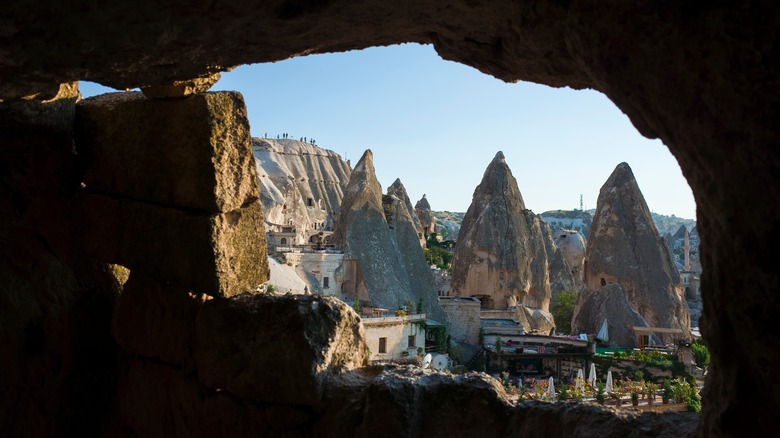You'll Feel Like You Just Stepped Out Of A Storybook When You Visit This Region Of Turkey
Turkey is a big country filled with remarkable sights, both manmade and natural, from the soaring domes of the Blue Mosque in Istanbul to the out-of-this-world landscape of the Pamukkale thermal springs. While many of its top tourist attractions are confined to the coast or the metropolis spanning Europe and Asia, one of its most popular destinations is at the heart of the country: Cappadocia. Known as Kapadokya to the locals, the forces of nature and the hands of humans have worked for the past 60 million years to create something that looks straight from the pages of a fantasy novel.
The entire region of Cappadocia covers around 5,000 square kilometers. However, the destination made world-famous by its peculiar geographical features is confined to an 80 square kilometer area in the Neveshir province. This UNESCO World Heritage site is where volcanic formations and spindly turrets of rock known as "fairy chimneys" create outlandish vistas that look like something J.R.R. Tolkien might have dreamt up. The landscape in this region would look strange enough without the ancient cave dwellings, churches, and monasteries cut into the rock. The sight is made even more surreal by the colorful hot air balloons drifting in the clear blue sky overhead. That's all before you venture beneath the surface and explore Derinkuyu, the vast underground city big enough to shelter 20,000 people.
What exactly is Cappadocia?
While the geological activity that gave Cappadocia its distinctive look occurred around 60 million years ago, it didn't attract human settlers until relatively recently. The harsh terrain made it unappealing to early man, who found a foothold in the region in Neolithic times. The only area with enough water and wildlife to support small communities was the site we think of when we hear "Cappadocia" today. It became an important trade hub in pre-Christian times and flourished under the peace of Turkish rule, peaking in the 11th and 12th Centuries when many of the more elaborate churches and monasteries were built. The region has around 600 ancient churches, and some of their frescoes are remarkably well-preserved, such as the works of art in the Dark Church in the Goreme Open Air Museum.
Cappadocia's underground city probably started as a place to store goods before substantially expanding to shelter thousands of people from invaders during the region's turbulent history, reaching its peak population during the Byzantine Era. Incredibly, it was only rediscovered in 1963 when a man knocked down a wall in his basement and found a tunnel leading into the underground labyrinth.
Tourism is adding a new layer to humankind's story in the Cappadocia region. Over 4 million people visited in 2022, and it's only natural that some want to get the full cave-dwelling experience, albeit with the wifi, jacuzzis, and infinity pools offered by cave hotels.
Things to do in Cappadocia
With thousands of years of human history to explore, there is an extensive array of things to see and do in Cappadocia. Goreme Open Air Museum is one of the most popular sites in the region, as it is home to some of the best-preserved rock churches and monasteries. The town of Ürgüp, once an important 11th-century castle city and now a lively tourist hub, is one of the area's most photogenic settlements, with its minarets mingling with fairy chimneys and rock formations. Nearby is the atmospheric Uchisar Castle, chiseled into a rocky outcrop, and the entrance to the underground city is found near the town of Derinkuyu.
During your visit to Cappadocia, you will undoubtedly see the ubiquitous hot air balloons drifting serenely over the landscape. Many companies offer the service, ranging from budget options to deluxe flights, including a buffet breakfast on board. Once you've had your fill of caves and frescoes and balloon rides, you might decide it is time to explore the landscape on foot.
Many hiking trails wind across the region, which will help you access some of Cappadocia's most beautiful spots. One highly recommended is the viewpoint at Red Valley. The cafe at the top is accessible by car, but a drink at sunset is made all the more special if you've had to work a little for it.


